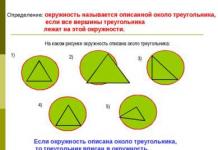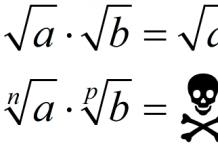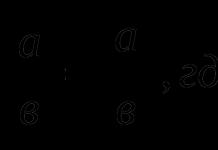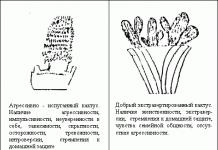Let us consider a certain plane π and an arbitrary point M 0 in space. Let's choose for the plane unit normal vector n with the beginning at some point M 1 ∈ π, and let p(M 0 ,π) be the distance from the point M 0 to the plane π. Then (Fig. 5.5)
р(М 0 ,π) = | pr n M 1 M 0 | = |nM 1 M 0 |, (5.8)
since |n| = 1.
If the π plane is given in rectangular coordinate system with its general equation Ax + By + Cz + D = 0, then its normal vector is the vector with coordinates (A; B; C) and we can choose

Let (x 0 ; y 0 ; z 0) and (x 1 ; y 1 ; z 1) be the coordinates of the points M 0 and M 1 . Then the equality Ax 1 + By 1 + Cz 1 + D = 0 holds, since the point M 1 belongs to the plane, and the coordinates of the vector M 1 M 0 can be found: M 1 M 0 = (x 0 -x 1; y 0 -y 1 ; z 0 -z 1 ). Recording scalar product nM 1 M 0 in coordinate form and transforming (5.8), we obtain

since Ax 1 + By 1 + Cz 1 = - D. So, to calculate the distance from a point to a plane you need to substitute the coordinates of the point into general equation plane, and then divide the absolute value of the result by the normalizing factor, equal to length the corresponding normal vector.
This article talks about determining the distance from a point to a plane. Let's analyze the coordinate method, which will allow us to find the distance from given point three-dimensional space. To reinforce this, let’s look at examples of several tasks.
The distance from a point to a plane is found using the known distance from a point to a point, where one of them is given, and the other is a projection onto a given plane.
When a point M 1 with a plane χ is specified in space, then through the point you can draw perpendicular to the plane direct. H 1 is common point their intersections. From this we obtain that the segment M 1 H 1 is a perpendicular drawn from point M 1 to the plane χ, where point H 1 is the base of the perpendicular.
Definition 1
Call the distance from a given point to the base of a perpendicular drawn from a given point to given plane.
The definition can be written in different formulations.
Definition 2
Distance from point to plane is the length of the perpendicular drawn from a given point to a given plane.
The distance from point M 1 to the χ plane is determined as follows: the distance from point M 1 to the χ plane will be the smallest from a given point to any point on the plane. If point H 2 is located in the χ plane and is not equal to point H 2, then we obtain a right triangle of the form M 2 H 1 H 2 , which is rectangular, where there is a leg M 2 H 1, M 2 H 2 – hypotenuse. This means that it follows that M 1 H 1< M 1 H 2 . Тогда отрезок М 2 H 1 is considered inclined, which is drawn from point M 1 to the plane χ. We have that the perpendicular drawn from a given point to the plane is less than the inclined one drawn from the point to the given plane. Let's look at this case in the figure below.

Distance from a point to a plane - theory, examples, solutions
There are a number of geometric problems whose solutions must contain the distance from a point to a plane. There may be different ways to identify this. To resolve, use the Pythagorean theorem or similarity of triangles. When, according to the condition, it is necessary to calculate the distance from a point to a plane, given in a rectangular coordinate system of three-dimensional space, it is solved by the coordinate method. This paragraph discusses this method.
According to the conditions of the problem, we have that a point in three-dimensional space with coordinates M 1 (x 1, y 1, z 1) with a plane χ is given; it is necessary to determine the distance from M 1 to the plane χ. Several solution methods are used to solve this problem.
First way
This method is based on finding the distance from a point to a plane using the coordinates of point H 1, which are the base of the perpendicular from point M 1 to the plane χ. Next, you need to calculate the distance between M 1 and H 1.
To solve the problem in the second way, use normal equation given plane.
Second way
By condition, we have that H 1 is the base of the perpendicular, which was lowered from point M 1 to the plane χ. Then we determine the coordinates (x 2, y 2, z 2) of point H 1. The required distance from M 1 to the χ plane is found by the formula M 1 H 1 = (x 2 - x 1) 2 + (y 2 - y 1) 2 + (z 2 - z 1) 2, where M 1 (x 1, y 1, z 1) and H 1 (x 2, y 2, z 2). To solve, you need to know the coordinates of point H 1.
We have that H 1 is the point of intersection of the χ plane with the line a, which passes through the point M 1 located perpendicular to the χ plane. It follows that it is necessary to compile an equation for a straight line passing through a given point perpendicular to a given plane. It is then that we will be able to determine the coordinates of point H 1. It is necessary to calculate the coordinates of the point of intersection of the line and the plane.
Algorithm for finding the distance from a point with coordinates M 1 (x 1, y 1, z 1) to the χ plane:
Definition 3
- draw up an equation of straight line a passing through point M 1 and at the same time
- perpendicular to the χ plane;
- find and calculate the coordinates (x 2 , y 2 , z 2) of point H 1, which are points
- intersection of straight line a with plane χ ;
- calculate the distance from M 1 to χ using the formula M 1 H 1 = (x 2 - x 1) 2 + (y 2 - y 1) 2 + z 2 - z 1 2.
Third way
In a given rectangular coordinate system O x y z there is a plane χ, then we obtain a normal equation of the plane of the form cos α · x + cos β · y + cos γ · z - p = 0. From here we obtain that the distance M 1 H 1 with the point M 1 (x 1 , y 1 , z 1) drawn to the plane χ, calculated by the formula M 1 H 1 = cos α x + cos β y + cos γ z - p . This formula is valid, since it was established thanks to the theorem.
Theorem
If point M 1 (x 1 , y 1 , z 1) is given in three-dimensional space, having a normal equation of the plane χ of the form cos α · x + cos β · y + cos γ · z - p = 0, then the distance from the point to the plane M 1 H 1 is calculated from the formula M 1 H 1 = cos α · x + cos β · y + cos γ · z - p, since x = x 1, y = y 1, z = z 1.
Proof
The proof of the theorem comes down to finding the distance from a point to a line. From here we get that the distance from M 1 to the χ plane is the modulus of the difference between the numerical projection of the radius vector M 1 with the distance from the origin to the χ plane. Then we get the expression M 1 H 1 = n p n → O M → - p. The normal vector of the plane χ has the form n → = cos α, cos β, cos γ, and its length is equal to one, n p n → O M → is the numerical projection of the vector O M → = (x 1, y 1, z 1) in the direction determined by the vector n → .
Let's apply the calculation formula scalar vectors. Then we obtain an expression for finding a vector of the form n → , O M → = n → · n p n → O M → = 1 · n p n → O M → = n p n → O M → , since n → = cos α , cos β , cos γ · z and O M → = (x 1 , y 1 , z 1) . The coordinate form of writing will take the form n → , O M → = cos α · x 1 + cos β · y 1 + cos γ · z 1 , then M 1 H 1 = n p n → O M → - p = cos α · x 1 + cos β · y 1 + cos γ · z 1 - p . The theorem is proven.
From here we get that the distance from the point M 1 (x 1, y 1, z 1) to the plane χ is calculated by substituting cos α · x + cos β · y + cos γ · z - p = 0 into the left side of the normal equation of the plane instead of x, y, z coordinates x 1, y 1 and z 1, relating to point M 1, taking the absolute value of the obtained value.
Let's consider examples of finding the distance from a point with coordinates to a given plane.
Example 1
Calculate the distance from the point with coordinates M 1 (5, - 3, 10) to the plane 2 x - y + 5 z - 3 = 0.
Solution
Let's solve the problem in two ways.
The first method starts with calculating the direction vector of the line a. By condition, we have that the given equation 2 x - y + 5 z - 3 = 0 is an equation of the plane general view, and n → = (2, - 1, 5) is the normal vector of the given plane. It is used as a direction vector of a straight line a, which is perpendicular to a given plane. Should be written down canonical equation a straight line in space passing through M 1 (5, - 3, 10) with a direction vector with coordinates 2, - 1, 5.
The equation will become x - 5 2 = y - (- 3) - 1 = z - 10 5 ⇔ x - 5 2 = y + 3 - 1 = z - 10 5.
Intersection points must be determined. To do this, gently combine the equations into a system to move from the canonical to the equations of two intersecting lines. This point let's take H 1. We get that
x - 5 2 = y + 3 - 1 = z - 10 5 ⇔ - 1 · (x - 5) = 2 · (y + 3) 5 · (x - 5) = 2 · (z - 10) 5 · ( y + 3) = - 1 · (z - 10) ⇔ ⇔ x + 2 y + 1 = 0 5 x - 2 z - 5 = 0 5 y + z + 5 = 0 ⇔ x + 2 y + 1 = 0 5 x - 2 z - 5 = 0
After which you need to enable the system
x + 2 y + 1 = 0 5 x - 2 z - 5 = 0 2 x - y + 5 z - 3 = 0 ⇔ x + 2 y = 1 5 x - 2 z = 5 2 x - y + 5 z = 3
Let us turn to the Gaussian system solution rule:
1 2 0 - 1 5 0 - 2 5 2 - 1 5 3 ~ 1 2 0 - 1 0 - 10 - 2 10 0 - 5 5 5 ~ 1 2 0 - 1 0 - 10 - 2 10 0 0 6 0 ⇒ ⇒ z = 0 6 = 0 , y = - 1 10 10 + 2 z = - 1 , x = - 1 - 2 y = 1
We get that H 1 (1, - 1, 0).
We calculate the distance from a given point to the plane. We take points M 1 (5, - 3, 10) and H 1 (1, - 1, 0) and get
M 1 H 1 = (1 - 5) 2 + (- 1 - (- 3)) 2 + (0 - 10) 2 = 2 30
The second solution is to first bring the given equation 2 x - y + 5 z - 3 = 0 to normal form. We determine the normalizing factor and get 1 2 2 + (- 1) 2 + 5 2 = 1 30. From here we derive the equation of the plane 2 30 · x - 1 30 · y + 5 30 · z - 3 30 = 0. The left side of the equation is calculated by substituting x = 5, y = - 3, z = 10, and you need to take the distance from M 1 (5, - 3, 10) to 2 x - y + 5 z - 3 = 0 modulo. We get the expression:
M 1 H 1 = 2 30 5 - 1 30 - 3 + 5 30 10 - 3 30 = 60 30 = 2 30
Answer: 2 30.
When the χ plane is specified by one of the methods in the section on methods for specifying a plane, then you first need to obtain the equation of the χ plane and calculate the required distance using any method.
Example 2
In three-dimensional space, points with coordinates M 1 (5, - 3, 10), A (0, 2, 1), B (2, 6, 1), C (4, 0, - 1) are specified. Calculate the distance from M 1 to plane A B C.
Solution
First you need to write down the equation of the plane passing through the given three points with coordinates M 1 (5, - 3, 10), A (0, 2, 1), B (2, 6, 1), C (4, 0, - 1) .
x - 0 y - 2 z - 1 2 - 0 6 - 2 1 - 1 4 - 0 0 - 2 - 1 - 1 = 0 ⇔ x y - 2 z - 1 2 4 0 4 - 2 - 2 = 0 ⇔ ⇔ - 8 x + 4 y - 20 z + 12 = 0 ⇔ 2 x - y + 5 z - 3 = 0
It follows that the problem has a solution similar to the previous one. This means that the distance from point M 1 to plane A B C has a value of 2 30.
Answer: 2 30.
Finding the distance from a given point on a plane or to a plane to which they are parallel is more convenient by applying the formula M 1 H 1 = cos α · x 1 + cos β · y 1 + cos γ · z 1 - p. From this we obtain that the normal equations of planes are obtained in several steps.
Example 3
Find the distance from a given point with coordinates M 1 (- 3 , 2 , - 7) to coordinate plane About x y z and the plane defined by the equation 2 y - 5 = 0.
Solution
The coordinate plane O y z corresponds to an equation of the form x = 0. For the O y z plane it is normal. Therefore, it is necessary to substitute the values x = - 3 into the left side of the expression and take the absolute value of the distance from the point with coordinates M 1 (- 3, 2, - 7) to the plane. We get a value equal to - 3 = 3.
After the transformation, the normal equation of the plane 2 y - 5 = 0 will take the form y - 5 2 = 0. Then you can find the required distance from the point with coordinates M 1 (- 3, 2, - 7) to the plane 2 y - 5 = 0. Substituting and calculating, we get 2 - 5 2 = 5 2 - 2.
Answer: The required distance from M 1 (- 3, 2, - 7) to O y z has a value of 3, and to 2 y - 5 = 0 has a value of 5 2 - 2.
If you notice an error in the text, please highlight it and press Ctrl+Enter
PROBLEMS C2 OF THE UNIFORM STATE EXAMINATION IN MATHEMATICS TO FIND THE DISTANCE FROM A POINT TO A PLANE
Kulikova Anastasia Yurievna
5th year student, Department of Math. analysis, algebra and geometry EI KFU, Russian Federation, Republic of Tatarstan, Elabuga
Ganeeva Aigul Rifovna
scientific supervisor, Ph.D. ped. Sciences, Associate Professor EI KFU, Russian Federation, Republic of Tatarstan, Elabuga
IN Unified State Exam assignments in mathematics in last years problems appear to calculate the distance from a point to a plane. In this article, using the example of one problem, we consider various methods finding the distance from a point to a plane. The most suitable method can be used to solve various problems. Having solved a problem using one method, you can check the correctness of the result using another method.
Definition. The distance from a point to a plane not containing this point is the length of the perpendicular segment drawn from this point to the given plane.
Task. Dan cuboid ABWITHD.A. 1 B 1 C 1 D 1 with sides AB=2, B.C.=4, A.A. 1 =6. Find the distance from the point D to plane ACD 1 .
1 way. Using definition. Find the distance r( D, ACD 1) from point D to plane ACD 1 (Fig. 1).
Figure 1. First method
Let's carry out D.H.⊥AC, therefore, by the theorem of three perpendiculars D 1 H⊥AC And (DD 1 H)⊥AC. Let's carry out direct D.T. perpendicular D 1 H. Straight D.T. lies in a plane DD 1 H, hence D.T.⊥A.C.. Hence, D.T.⊥ACD 1.
ADC let's find the hypotenuse AC and height D.H.
![]()
From a right triangle D 1 D.H. let's find the hypotenuse D 1 H and height D.T.
![]()

Answer: .
Method 2.Volume method (use of an auxiliary pyramid). A problem of this type can be reduced to the problem of calculating the height of a pyramid, where the height of the pyramid is the required distance from a point to a plane. Prove that this height is the required distance; find the volume of this pyramid in two ways and express this height.
Note that with this method there is no need to construct a perpendicular from a given point to a given plane.
A cuboid is a parallelepiped all of whose faces are rectangles.
AB=CD=2, B.C.=AD=4, A.A. 1 =6.
The required distance will be the height h pyramids ACD 1 D, lowered from the top D on the base ACD 1 (Fig. 2).
Let's calculate the volume of the pyramid ACD 1 D two ways.
When calculating, in the first way we take ∆ as the base ACD 1 then
![]()
When calculating in the second way, we take ∆ as the base ACD, Then
![]()
Let us equate the right-hand sides of the last two equalities and obtain
![]()
![]()

Figure 2. Second method
From right triangles ACD, ADD 1 , CDD 1 find the hypotenuse using the Pythagorean theorem
ACD
![]()
Calculate the area of the triangle ACD 1 using Heron's formula
![]()
Answer: .
3 way. Coordinate method.
Let a point be given M(x 0 ,y 0 ,z 0) and plane α , given by the equation ax+by+cz+d=0 in rectangular Cartesian system coordinates Distance from point M to the plane α can be calculated using the formula:

Let us introduce a coordinate system (Fig. 3). Origin of coordinates at a point IN;
Straight AB- axis X, straight Sun- axis y, straight BB 1 - axis z.

Figure 3. Third method
B(0,0,0), A(2,0,0), WITH(0,4,0), D(2,4,0), D 1 (2,4,6).
Let ax+by+ cz+ d=0 – plane equation ACD 1 . Substituting the coordinates of points into it A, C, D 1 we get:

![]()
Plane equation ACD 1 will take the form
Answer: .
4 way. Vector method.
Let us introduce the basis (Fig. 4) , .

Figure 4. Fourth method
, Competition "Presentation for the lesson"
Class: 11
Presentation for the lesson
Back forward
Attention! Slide previews are for informational purposes only and may not represent all the features of the presentation. If you are interested in this work, please download the full version.
Goals:
- generalization and systematization of students’ knowledge and skills;
- development of skills to analyze, compare, draw conclusions.
Equipment:
- multimedia projector;
- computer;
- sheets with problem texts
PROGRESS OF THE CLASS
I. Organizational moment
II. Knowledge updating stage(slide 2)
We repeat how the distance from a point to a plane is determined
III. Lecture(slides 3-15)
In class we will look at various ways finding the distance from a point to a plane.
First method: step-by-step computational
Distance from point M to plane α:
– equal to the distance to the plane α from an arbitrary point P lying on a straight line a, which passes through the point M and is parallel to the plane α;
– is equal to the distance to the plane α from an arbitrary point P lying on the plane β, which passes through the point M and is parallel to the plane α.
We will solve the following problems:
№1. In cube A...D 1, find the distance from point C 1 to plane AB 1 C.

It remains to calculate the length of the segment O 1 N.

№2. In a regular hexagonal prism A...F 1, all edges of which are equal to 1, find the distance from point A to the plane DEA 1.


Next method: volume method.
If the volume of the pyramid ABCM is equal to V, then the distance from point M to the plane α containing ∆ABC is calculated by the formula ρ(M; α) = ρ(M; ABC) =
When solving problems, we use the equality of volumes of one figure, expressed in two different ways.
Let's solve the following problem:
№3. Edge AD of pyramid DABC is perpendicular to the base plane ABC. Find the distance from A to the plane passing through the midpoints of the edges AB, AC and AD, if.


When solving problems coordinate method the distance from point M to plane α can be calculated using the formula ρ(M; α) = ![]() , where M(x 0; y 0; z 0), and the plane is given by the equation ax + by + cz + d = 0
, where M(x 0; y 0; z 0), and the plane is given by the equation ax + by + cz + d = 0
Let's solve the following problem:
№4. In a unit cube A...D 1, find the distance from point A 1 to plane BDC 1.
Let's introduce a coordinate system with the origin at point A, the y-axis will run along edge AB, the x-axis along edge AD, and the z-axis along edge AA 1. Then the coordinates of the points B (0; 1; 0) D (1; 0; 0;) C 1 (1; 1; 1)
Let's create an equation for a plane passing through points B, D, C 1.
Then – dx – dy + dz + d = 0 x + y – z – 1= 0. Therefore, ρ = ![]()
The following method that can be used to solve problems of this type is method of support problems.
Application this method consists in the application of known reference problems, which are formulated as theorems.

Let's solve the following problem:
№5. In a unit cube A...D 1, find the distance from point D 1 to plane AB 1 C.

Let's consider the application vector method.
№6. In a unit cube A...D 1, find the distance from point A 1 to plane BDC 1.


So, we looked at various methods that can be used to solve this type of problem. The choice of one method or another depends on the specific task and your preferences.
IV. Group work
Try solving the problem in different ways.
№1. The edge of the cube A...D 1 is equal to . Find the distance from vertex C to plane BDC 1.
№2. In a regular tetrahedron ABCD with an edge, find the distance from point A to the plane BDC
№3. In a regular triangular prism ABCA 1 B 1 C 1 all edges of which are equal to 1, find the distance from A to the plane BCA 1.
№4. In a regular quadrilateral pyramid SABCD, all edges of which are equal to 1, find the distance from A to the plane SCD.
V. Lesson summary, homework, reflection
, Competition "Presentation for the lesson"
Class: 11
Presentation for the lesson
Back forward
Attention! Slide previews are for informational purposes only and may not represent all the features of the presentation. If you are interested in this work, please download the full version.
Goals:
- generalization and systematization of students’ knowledge and skills;
- development of skills to analyze, compare, draw conclusions.
Equipment:
- multimedia projector;
- computer;
- sheets with problem texts
PROGRESS OF THE CLASS
I. Organizational moment
II. Knowledge updating stage(slide 2)
We repeat how the distance from a point to a plane is determined
III. Lecture(slides 3-15)
In this lesson we will look at various ways to find the distance from a point to a plane.
First method: step-by-step computational
Distance from point M to plane α:
– equal to the distance to the plane α from an arbitrary point P lying on a straight line a, which passes through the point M and is parallel to the plane α;
– is equal to the distance to the plane α from an arbitrary point P lying on the plane β, which passes through the point M and is parallel to the plane α.
We will solve the following problems:
№1. In cube A...D 1, find the distance from point C 1 to plane AB 1 C.

It remains to calculate the length of the segment O 1 N.

№2. In a regular hexagonal prism A...F 1, all edges of which are equal to 1, find the distance from point A to the plane DEA 1.


Next method: volume method.
If the volume of the pyramid ABCM is equal to V, then the distance from point M to the plane α containing ∆ABC is calculated by the formula ρ(M; α) = ρ(M; ABC) =
When solving problems, we use the equality of volumes of one figure, expressed in two different ways.
Let's solve the following problem:
№3. Edge AD of pyramid DABC is perpendicular to the base plane ABC. Find the distance from A to the plane passing through the midpoints of the edges AB, AC and AD, if.


When solving problems coordinate method the distance from point M to plane α can be calculated using the formula ρ(M; α) = ![]() , where M(x 0; y 0; z 0), and the plane is given by the equation ax + by + cz + d = 0
, where M(x 0; y 0; z 0), and the plane is given by the equation ax + by + cz + d = 0
Let's solve the following problem:
№4. In a unit cube A...D 1, find the distance from point A 1 to plane BDC 1.
Let's introduce a coordinate system with the origin at point A, the y-axis will run along edge AB, the x-axis along edge AD, and the z-axis along edge AA 1. Then the coordinates of the points B (0; 1; 0) D (1; 0; 0;) C 1 (1; 1; 1)
Let's create an equation for a plane passing through points B, D, C 1.
Then – dx – dy + dz + d = 0 x + y – z – 1= 0. Therefore, ρ = ![]()
The following method that can be used to solve problems of this type is method of support problems.
The application of this method consists in the use of known reference problems, which are formulated as theorems.

Let's solve the following problem:
№5. In a unit cube A...D 1, find the distance from point D 1 to plane AB 1 C.

Let's consider the application vector method.
№6. In a unit cube A...D 1, find the distance from point A 1 to plane BDC 1.


So, we looked at various methods that can be used to solve this type of problem. The choice of one method or another depends on the specific task and your preferences.
IV. Group work
Try solving the problem in different ways.
№1. The edge of the cube A...D 1 is equal to . Find the distance from vertex C to plane BDC 1.
№2. In a regular tetrahedron ABCD with an edge, find the distance from point A to the plane BDC
№3. In a regular triangular prism ABCA 1 B 1 C 1 all edges of which are equal to 1, find the distance from A to the plane BCA 1.
№4. In a regular quadrilateral pyramid SABCD, all edges of which are equal to 1, find the distance from A to the plane SCD.
V. Lesson summary, homework, reflection


























